|
|
Home > Fact Sheets > Air Force Heritage Pamphlet
AIR FORCE HERITAGE PAMPHLET
Posted 2/11/2008
 Printable Fact Sheet
Printable Fact Sheet
Air Force Heritage
General Merrill A. McPeak
United States Air Force Chief of Staff (1990-1994)
Reproduced from the pamphlet Air Force Heritage produced by the Air Force News Agency.
Combat is often an individual event, like, say, tennis. It sometimes comes down to pilot versus pilot, one versus one. And so we recognize individual achievement, or personal valor. But, more often than not, combat is a team sport, more like soccer than tennis. Individuals still score, but it's the team effort that makes scoring possible. This is why it's so important for us to pay attention to team performance, to the units that people served in, to the flags that have flown under circumstances that cause us the greatest pride.
We've taken a comprehensive look back at wing and squadron flags across all communities -- fighter; bomber; mobility; missile; command, control, communications and intelligence; trainers; space; test; special operations -- all of them. Before this initiative, our heritage preservation effort -- such as it was -- was disjointed. Each command was left to its own approach. Commanders who cared -- and many didn't -- watched over their own small pot of unit flags. It was to prevent the piecemeal loss of our legacy that we decided on a systematic, three-step approach.
First, we looked at the age of our formations. By the early 1930s, we had established 13 combat groups. Of course, these groups are called wings today, but their numbers and their heritage still carry through. These groups and their squadrons are the oldest combat organizations we have -- kind of the original Air Force -- our elder statesmen. If you go back to the cities, towns, and villages of this country, these are the units people would most associate themselves with. This is true because, simply by being on the books for 50 or 60 years, more Air Force men and women would have cycled through these units. So, we first resolved to protect our oldest units, to keep these original 13 flags flying.
Second, we looked at units established starting about 1940, during the rapid buildup for the Second World War. Here, the issue was not age, but unit achievement. We identified flags with illustrious accomplishments to their credit, the flags that had literally earned the right to keep flying. We didn't reach for particular specifics - preferring instead to let the history speak for itself.
This list would include units like: the 23rd Wing -- the Flying Tigers; the 4th Wing -- with the Royal Air Force's eagle squadrons and more combat kills than any other wing; the 56th Wing- - with 39 aces; the 60th Wing -- which made our first paratroop drop of World War II, helped in the Berlin Airlift and made the first jet landing in the Antarctic; and the 305th Wing -- whose logbook includes Schweinfurt, the Battle of the Bulge and a commander named LeMay.
There are so many more -- but you get the idea. We also wanted to keep wing flags in each operating element of the Air Force, so we tried to find fighter flags and bomber flags and missile flags, and so forth, of special distinction.
So, we decided first to preserve our 13 oldest wings. Second, we identified a small number of additional wings that had a record of special accomplishment. As you might expect, there is some overlap here, because some of our original 13 flags have served with great distinction. But for our purposes, it didn't matter. The 13 oldest were given a bye into the finals and were joined there by the units that fought their way through the qualifying rounds.
The final step was to rank order the remaining wing flags. Here we used a scoring system with points awarded for years of service, decorations, streamers, aerial victories, and so on. We've done exactly the same thing for squadron flags that I've described for wings. That is, we've identified our oldest and our most distinguished squadrons and have rank ordered the rest.
Now, the idea is, as our force structure continues to shrink, the oldest and the most distinguished flags will be keepers. We will [inactivate] and turn in other wing and squadron flags, starting with units that have the lowest heritage scores. As installations close, we'll move unit flags around to ensure the keepers are protected. We will no doubt take some criticism for this. Some will say, "What difference does it make? You take one number down over the door and put another one up. So what?" We can't really respond to these critics because they don't understand the institution. If the numbers don't mean anything to them - if heritage isn't important to them -- they'll never understand what we're about.
I don't expect we'll see much of this kind of criticism inside the Air Force. We haven't been in business long -- less than 50 years. Even so, most Air Force people understand the importance of pride and roots. A second kind of criticism will be more effective because there is a certain cost to doing this. We'll have to change signs around the base. We'll have to order new patches and new stationery and so forth. I've put out guidance that says don't repaint wholesale -- wait until it's necessary. Don't buy new stationery until the old stock is used up and so on. We'll try to think it through so people don't have to go through this two or three times. But, in the end, there will be a certain cost associated with this initiative.
In the context of our mission, the costs are trivial. I have absolutely no doubt that we'll be a better organization to accomplish our mission if we preserve our heritage. In fact, this may be the lowest cost approach to increasing combat effectiveness. Anything else we do -- enhancing training or buying better equipment or improving facility support -- would certainly cost more.
I don't suppose any of this would make much difference if the Air Force were growing - or even if it were staying the same size. Then all our organizations -- all our flags -- would be safe. But the problem in the Pentagon is that the drawdown is putting our heritage at risk -- causing us to fold and shelve many proud unit flags. To me, these flags are more than symbols -- they are living reminders of values that define the Air Force.
If we're not careful, just taking down a squadron here, a wing there, we'll whittle away at our legacy, we'll create a new kind of hollow Air Force - one that's lost its heritage, its heroes, its famous campaigns, its core values.
These are our roots: the historic emblems of 13 original combat air groups formed by the Army before World War II.
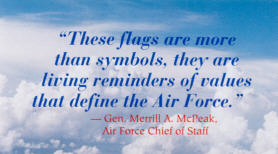 There were 18, but five were disbanded in the 1930s and 1940s - none passing on their heritage to future Air Force wings. And so we have these 13, with their bold and brilliant shields. Some display the official Air Service colors of green and black. Later emblems embody the sky and the sun in blue and yellow - the Air Force's official colors. There were 18, but five were disbanded in the 1930s and 1940s - none passing on their heritage to future Air Force wings. And so we have these 13, with their bold and brilliant shields. Some display the official Air Service colors of green and black. Later emblems embody the sky and the sun in blue and yellow - the Air Force's official colors.
Even as this historical effort is under way, General McPeak reminds us of Gen. Carl Spaatz's leadership in the 1950s with this same endeavor - the reason the former chief of staff established the Air Force Historical Foundation in 1953.
Spaatz gave one charge to the group - "preserve and perpetuate the history and traditions of the Air Force and of the people who've devoted their lives to its service."
So as we streamline, we remember our heritage - the first 13 were just a beginning.
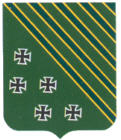
1st Pursuit Group
History: Organized in France in May 1918, the 1st Pursuit Group's pilots included World War I aces Eddie Rickenbacker and Frank Luke. The group was demobilized, but another 1st Pursuit Group was organized in 1919 at Selfridge Field, Mich., and inherited the group's lineage. After several name changes, the 1st Fighter Group flew across the Atlantic with P-38 fighters in mid-1942. In July 1947 the group was incorporated into the 1st Fighter Wing at March Field, Calif. Following inactivations and redesignations, the wing moved to Langley AFB, Va., in July 1975 to become the first F-15 combat unit. The 1st FW led the Desert Shield deployment in August 1990 and provided air superiority during the Persian Gulf war.
Heraldry: The group's emblem was approved in February 1924. The five stripes stand for the original five squadrons, and the crosses represent the group's five campaigns during World War I.
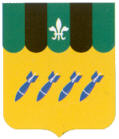
2nd Bombardment Group
History: Organized in France as the 1st Day Bombardment Group in September 1918, the unit was demobilized after the armistice. The group consolidated in 1924 with the 2nd Bombardment Group at Langley Field, Va., which had participated in Billy Mitchell's demonstration of how aircraft could sink battleships. During World War II, the group flew B-17s from bases in North Africa and Italy. In 1947 it became part of the 2nd Bombardment Wing at Davis-Monthan AFB, Ariz. Based since 1963 at Barksdale AFB, La., the wing flew the longest combat mission of all time in January 1991 when several B-52s hit key targets in Iraq on the opening night of the Persian Gulf war.
Heraldry: The group's emblem was approved in 1924. The bombs signify original squadrons, the stripes represent major World War I offensives, and the white fleur de lis symbolizes the French location of the battles.
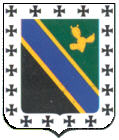
3rd Attack Group
History: Organized in 1919 at Kelly Field, Texas, as a surveillance group, it became an attack group in 1921. Redesignated in 1939 as a bombardment group, it deployed to Australia after Pearl Harbor and flew A-20s and B-25s. It moved in September 1945 to Japan and became part of the 3rd Bombardment Wing in 1948. Its B-26s entered the Korean War in June 1950. It became the 3rd Tactical Fighter Wing in 1964 and saw combat service in Vietnam. Redesignated the 3rd Wing, it moved from its longtime home at Clark AB, the Philippines, to Elmendorf AFB, Alaska, after the eruption of Mount Pinatubo in 1991.
Heraldry: The emblem, approved in 1922, features the old Air Service colors with a prickly pear cactus commemorating early service patrolling the Mexican border. The 19 German crosses allude to victory credits accumulated by its World War I squadrons.
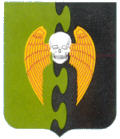
5th Group (Composite)
History: Organized in Hawaii in 1919 as the 2nd Group (Observation), it was redesignated the 5th Group (Composite) in 1922 and the 5th Bombardment Group (Heavy) in 1940. The group deployed in 1942 to the Southwest Pacific, where its B-17s and B-24s conducted long-range missions against Japanese forces. In 1949, the group joined the 5th Strategic Reconnaissance Wing at Mountain Home AFB, Idaho, then moved to Travis AFB, Calif. It became the 5th Bombardment Wing in 1955. This wing, which converted from B-36s to B-52s in 1958, has been at Minot AFB, N.D., since 1968. Its KC-135 tankers participated in the Persian Gulf war.
Heraldry: The group's emblem, approved in 1924, features a winged death's head as an uncompromising symbol of its combat mission.
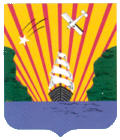
6th Group (Composite)
History: Organized in the Panama Canal Zone as the 3rd Observation Group in 1919, it was redesignated the 6th Group (Composite) in 1922 and the 6th Bombardment Group in 1937. It was disbanded in 1943, but consolidated in June 1944 with the 6th Bombardment Group (Very Heavy). Equipped with new B-29s, it began flying missions from Tinian against Japan in late 1944. Inactivated in 1948, it became part of the 6th Bombardment Wing at Walker AFB, N.M., in 1951. The wing moved to Eielson AFB, Alaska, in 1967 as the 6th Strategic Wing, and became a strategic reconnaissance wing in 1988. Inactivated in 1992, it was reactivated as the 6th Air Base Wing at MacDill AFB, Fla., in January 1994.
Heraldry: The group's emblem, approved in 1924, reflects its origins with a ship sailing through the Gaillard Cut and an airplane flying overhead.
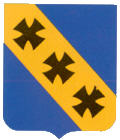
7th Bombardment Group
History: Activated in 1928, it inherited the lineage of the 1st Army Observation Group, which was stationed at Langley Field, Va., from 1919 to 1921. After serving in California, the group's B-17s were sent to reinforce the Philippines. Twelve aircraft landed in Hawaii during the Pearl Harbor attack. The group diverted to Java to attempt to stem the Japanese conquest of the Dutch East Indies. In 1942, it moved to India and flew missions over China and Southeast Asia for the rest of the war. After a brief inactivation, the group returned to duty in 1946 and became part of the 7th Bombardment Wing at Carswell AFB, Texas. Its B-52s and KC-135s conducted operations in Vietnam from 1965 to 1975, and the wing deployed KC-135s to the Gulf war in 1991. As the 7th Wing, it moved to Dyess AFB, Texas, in 1993 to fly B-1Bs and C-130s.
Heraldry: The group's emblem, approved in 1933, features three crosses symbolizing its squadrons' battle honors. The diagonal stripe was taken from the coat of arms of Province of Lorraine which France took back from Germany in World War I.
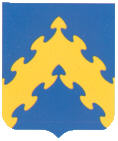
8th Pursuit Group
History: Activated in 1931 at Langley Field, Va., the group moved to Mitchel Field, N.Y., in 1940 before deploying to Australia in 1942. Its P-38s, P-39s and P-40s performed combat missions across the Southwest Pacific. Based in Japan after World War II as part of the 8th Fighter-Bomber Wing, the group flew combat missions throughout the Korean War. Redesignated the 8th Tactical Fighter Wing in 1958, it remained in Japan until 1964. After a year in California, it moved to Southeast Asia, where its F-4 crews earned the nicknames "MiG killers" and "bridge busters"; In 1974 the wing relocated to Kunsan AB, Korea, where it was redesignated the 8th Fighter Wing in 1992.
Heraldry: The group's emblem, approved in 1934, is a simple chevron in the stylized shape of clouds.
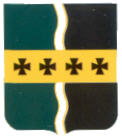
9th Group (Observation)
History: Organized in 1922 at Mitchel Field, N.Y., the group was redesignated the 9th Bombardment Group in 1935. It moved to Panama in 1940 with B-17s to defend the Canal Zone and later hunted German U-boats in the Caribbean. It returned to the United States in 1942, converted to B-29s, then deployed in 1944 to bomb Japan. The group inactivated in 1948, but reactivated later at what became Travis AFB, Calif., as part of the 9th Strategic Reconnaissance Wing. After serving at Mountain Home AFB, Idaho, from 1953 to 1966, the wing moved to Beale AFB, Calif. From here, the wing's U-2s and SR-71s conducted worldwide reconnaissance missions during the Cold War.
Heraldry: The wavy line in the group's emblem, approved in 1924, represents the Rio Grande to recognize a squadron that served along the Mexican border from 1913 to 1917.
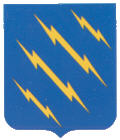
16th Pursuit Group
History: Activated in the Panama Canal Zone in 1932, the group was equipped with P-40s in 1941 and redesignated the 16th Fighter Group in 1942. The group disbanded in 1943. In 1993, the group was re established and consolidated with the 1st Special Operations Wing, which had been activated in 1944 in Burma as the 1st Commando Group. Inactivated in 1945, the group was activated again at Hurlburt Field, Fla., in 1962 and elevated to wing status in 1963. Equipped with a variety of aircraft, it carries out special operations training and unconventional warfare operations worldwide. It became the 16th Special Operations Wing in 1995.
Heraldry: The group's emblem, approved in 1934, has four lightning bolts -- representing the four assigned squadrons -- depicting destruction from the sky.
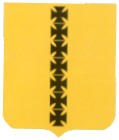
17th Pursuit Group
History: Activated in July 1931 at March Field, Calif., it became the 17th Attack Group in 1935 and 17th Bombardment Group (Medium) four years later. Commanded by Lt. Col. James Doolittle, 16 B-25s of this group launched from the aircraft carrier USS Hornet to bomb Tokyo, on April 18, 1942. The group deployed to North Africa in late 1942 with B-26s, and ended the war based in France. Inactivated in 1945, it returned to duty in 1952 flying B-26s in Korea as part of the 17th Bombardment Wing (Light). After several moves, it was inactivated in 1958. The 17th Bombardment Wing (Heavy) was reactivated with B-52s at Wright-Patterson AFB, Ohio, in 1962 and moved to Beale AFB, Calif., before inactivation in 1976. The 17th Reconnaissance Wing was activated in 1982 at RAF Alconbury, England, and flew TR-ls until inactivation in 1991. To carry the lineage, the Goodfellow Technical Training Wing at San Angelo, Texas, was replaced by the 17th Training Wing in 1993.
Heraldry: The emblem, approved in 1934, features seven crosses in memory of World War I battles fought by one of its squadrons.
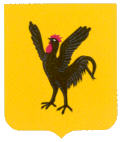
18th Pursuit Group
History: Organized in 1927 at Wheeler Field, Hawaii, the group lost most of its P-40s during the Pearl Harbor attack. After converting to P-38s, the redesignated 18th Fighter Group flew from Guadalcanal, New Guinea and the Philippines during World War II. The group deployed to Korea with F-51s in 1950 and was joined by the 18th Fighter-Bomber Wing. After converting to F-86s, the wing moved to Kadena AB, Okinawa, in 1954. Renamed the 18th Tactical Fighter Wing in 1958, it deployed RF-l0ls and F-105s -- and later, RF-4s and F-4s -- to Southeast Asia. After Vietnam, the wing received F-15s and as the 18th Wing in 1991 responsibility for a composite force.
Heraldry: The fighting cock emblem, approved in 1931, symbolizes the courage and aggressiveness of a combat organization.
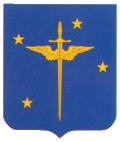
19th Bombardment Group
History: Based at Rockwell and March fields in California from 1932 to 1941,the 19th Bombardment Group moved to the Philippines in 1941. After the Japanese invasion, the group fought from Australia and Java until returning to the United States in 1942. After converting to B-29s, the 19th Bombardment Group (Very Heavy) moved in 1945 to Guam, where it later became part of the 19th Bombardment Wing (Medium). In 1950, the group's B-29s moved to Okinawa for the Korean War. After many aircraft changes and relocations, the wing moved to Robins AFB, Ga., in 1968 and sent its B-52s and tankers to Southeast Asia. It became an air refueling wing in 1983, and deployed its KC-135Rs and EC-135s to Southwest Asia and other locations worldwide.
Heraldry: The group's emblem, approved in 1936, shows a winged sword in front of the constellation of Pegasus, indicating both the striking force and navigation capability of the unit.
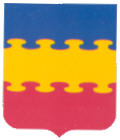
20th Pursuit Group
History: Activated in 1930 at Mather Field, Calif., the group was stationed at various locations before moving to England as the 20th Fighter Group in 1943, flying P-38s and later P-51s. The group was inactivated in 1945, but reborn less than a year later and moved to Shaw Field, S.C. In 1952, the group -- as part of the 20th Fighter-Bomber Wing -- returned to England with F-84s. The wing absorbed the group in 1955, converted to F-100s in 1957 and was redesignated the 20th Tactical Fighter Wing in 1958. Converting to F-llls, the wing moved to Upper Heyford, England, in 1970 and expanded to include EF-111s in 1983. With the post-Cold War withdrawal of American forces from Europe, the 20th Fighter Wing moved back to Shaw AFB, S.C., in January 1994.
Heraldry: The group's austere emblem, approved in 1934, features a nebula -- the heraldic symbol for clouds.
Reproduced from the pamphlet Air Force Heritage produced by the Air Force News Agency.
|  |
|
|
 |
|